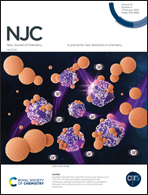Biphenyl furanocoumarin compounds inhibit SARS-CoV-2 spike pseudovirus infection by binding ACE2†
Abstract
Coronavirus disease 2019 (COVID-19), caused by severe acute respiratory syndrome coronavirus type 2 (SARS-CoV-2), is a highly infectious disease with a significant impact on global public health security, and the development of effective antiviral drugs is warranted. In this study, based on HEK293 membrane chromatography (CMC) model that overexpresses angiotensin-converting enzyme 2 (ACE2), we screened six compounds with long retention time on ACE2h/CMC, namely BU-1 to BU-6, from the biphenyl furanocoumarin compounds previously synthesized by our team. The binding properties of the screened compounds to ACE2 were investigated by frontier analysis. Cytotoxicity assay, virtual molecular docking assay and pseudo-viral invasion assay were used to examine the affinity and potential antiviral activity of the selected compounds towards ACE2 protein. The virtual molecular docking results showed that BU-1, BU-2 and BU-5 could form significant hydrogen bonds with hotspot amino acid residues on the ACE2 receptor. And BU-1, BU-2 and BU-5 significantly inhibited the ability of SARS-COV-2 pseudovirus to enter ACE2h cells. Therefore, BU-1, BU-2 and BU-5 have the potential to be used as lead compounds for further modification to develop more effective anti-SARS-CoV-2 drugs.



 Please wait while we load your content...
Please wait while we load your content...